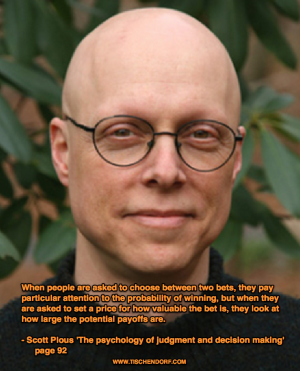It’s been a while since I last posted an excerpt. So here you are. An excerpt post citing a small passage from one of my favourite books. Although the book is not about trading, all of the topics covered are more or less directly related to trading. The book in question is from Scott Plous: ‘The Psychology of Judgment and Decision Making’. If you haven’t read the book yet I highly recommend doing so. Here’s a quote to pique your interest:
When people are asked to choose between two bets, they pay particular attention to the probability of winning, but when they are asked to set a price for how valuable the bet is, they look at how large the potential payoffs are. – Scott Plous ‘The psychology of judgment and decision making’ page 92
Another topic covered is about the so-called ‘Sunk Cost Effect’ which is part of the ‘Behavioral Traps‘ chapter covering ‘Investment Traps’. The reason I decided to write about this subject should be pretty obvious. It is closely related to the topics I frequently write about:
- Cutting Losses
- The Need To Be Right
- Emotional Detachment – Trading Lesson
- Seeking Exposure To New Opportunities
Here is the excerpt using a vivid example outlining the problem of sunk costs:
Scott Plous: ‘The Psychology of Judgment and Decision Making’ 1993 Edition, Pages 243-244:
“Investment Traps:
Cross and Guyer (1980) did not explicitly include investment traps in their taxonomy, but this type of trap has recently become the topic of a great deal of research. Investment traps occur when prior expenditures of time, money, or other resources lead people to make choices they would not otherwise make. In the parlance of decision research, these traps result in “sunk cost effects.” Hal Arkes and Catherine Blumer (1985) illustrated the effects of sunk costs in 10 different mini-experiments. In one of these experiments, a group of subjects were given the following problem:
As the president of an airline company , you have invested 10 million dollars of the company’s money into a research project. The purpose was to build a plane that would not be detected by conventional radar, in other words, a radar-blank plane. When the project is 90% completed, another firm begins marketing a plane that cannot be detected by radar. Also, it is apparent that their plane is much faster and far more economical than the plane your company is building. The question is: should you invest the last 10% of the research funds to finish your radar-blank plane?
[…] Arkes and Blumer found that 85 percent of their subjects recommended completing the project, even though the finished aircraft would be inferior to another plane already on the market. When a second group of subjects were given a version of the problem that did not mention prior investments, however, only 17 percent opted to spend money on the project. A sunk cost of $10 million made the difference.”
The whole point about sunk costs is that it takes guts and discipline to divorce your ego from trading and instead strive to make sound decisions regardless of the time and money you’ve spent. As a trader it is pretty obvious which situation I am referring to. The losing position in one’s portfolio one cannot possibly sell because so many emotions are attached to it. The research one has done. The beliefs one has developed about management and the company itself . The list goes on and on.
Successful traders do not think that way. They see a losing position for what it is. It is just a losing trade and they need to move on and avoid getting exposure to all the risks associated with sunk costs. Kill your losers, no hard feelings.
Holding on to a loser is conceptually the same as averaging down.
Twitter: https://twitter.com/tischendorf
I am now in my 26th year of actively trading the markets. With my Educational Product you get access to 350+ hours of video content. Every week you get a 60-90 min video reviewing New Trends & Charts from the Focused Watch List helping you with Idea Generation. I pass along everything I know about the Markets, Trading Psychology and Technical Analysis.
Profit from 25+ years of trading experience. Get early exposure to leading stocks!
Tischendorf Letter Premium

{ 6 trackbacks }
Comments on this entry are closed.